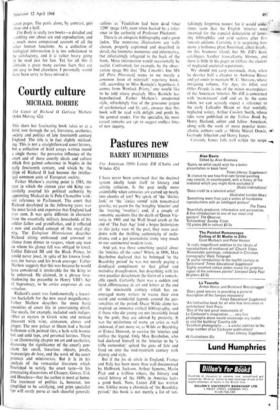Courtly culture
MICHAEL BORRIE
The Court of Richard II Gervase Mathew !John Murray 42s)
This short but fascinating book takes us at a brisk trot through the art, literature, aesthetics, society and politics of late fourteenth century England. The title is in fact slightly mislead- ing. This is not a straightforward court history, but a collection of brief essays written round a single theme: the pervasive influence of the court and of those courtly ideals and culture which first gained coherence in Naples in the early fourteenth century, and which by the reign of Richard II had become the intellec- tpal common coin of European society.
Father Mathew's starting point is 1383, the year in which the sixteen year old King suc- cessfully asserted his political authority by appointing Michael de la Pole Chancellor with- thit reference to Parliament. The court that Richard developed in the following years was the most lavish and expensive that England had ever seen. It was quite different in character from the essentially military households of his soldier father and grandfather, and it reflected a new and exalted concept of the royal dig- nity. The Eulogium Historiarum describes Richard sitting enthroned and crowned in silence from dinner to vespers, when any man on whom his glance fell was obliged to kneel. Unlike Edward III and the Black Prince, he Would never joust, in spite of his known fond- ness for horses and his brash courage: Father Mathew suggests that this was because he would have considered it intolerable for the King to be unhorsed. He claimed, in a phrase fore- shadowing the preamble to Henry VIII's Act of Supremacy, to be entier emperour de son soiaulme.
Richard's court was fundamentally a luxuri- ous backcloth for the new royal magnificence. Father Mathew describes the more basic amenities of court life in entertaining detail. The meals, for example, included such indiges- tibles• as oysters in Greek wine and minced pheasant with wine, cinnamon, cloves and ginger. The new palace at Sheen had a heated bathroom with painted tiles, a bath with bronze hot and cold taps, and personal latrines. There is an illuminating chapter on art and aesthetics, discussing the significance of the court's pen- chant for small, luxurious objects, jewels, manuscripts de luxe, and the work of the court painters and miniaturists. But it is in his analysis of the vernacular literature which flourished to satisfy the court taste—in his penetrating discussions of Chaucer, Gower, Usk and Hoccleve—that the author is most at home. The treatment of politics is, however, too simplified to be satisfying, and prim specialist lips will surely purse at such cheerful generali- sations - as '`Feudalism hid been dead -since 1290' (page 143), even when backed by a refer- ence to the authority of Professor Plucknett.
There is an adequate bibliography and a good index. The numerous illustrations are well- chosen, properly captioned and described in detail, the footnotes numerous and informative, but infuriatingly relegated to the back of the book. More information would occasionally be useful. Confronted, for example, by the obser- vation (page 86) that 'The Lincoln's Inn MS [of Piers Plowman] seems to me merely a common form of minstrels' repertory book; still, according to Miss Barnicle's hypothesis it comes from Wenlock Priory,' one would like to be told where precisely Miss Barnicle has hypothesised. Father Mathew's unadorned style, refreshingly free of the gruesome jargon of art-historical and lit. crit., ensures that this book will be read with delight and profit by the general reader. For the specialist, his most casual remarks are apt to suggest endless lines of new inquiry.










































 Previous page
Previous page